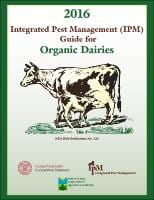Controlling arthropod pests on dairy cattle improves their general living conditions, which can directly affect farm profitability. Inadequate pest control can cause pain and irritation to animals, resulting in reduced milk production and a decrease in the rate of weight gain due to interrupted grazing time. Animal health is compromised through blood loss, hide damage, and hair degradation as well as providing routes for diseases such as pink eye, Thelazia eyeworms, and mastitis.
It is difficult to assess the impact of any one pest species on overall production, but an accumulation of multiple stresses from pests throughout the year will reduce production over time, with conservative estimated losses of five percent or more. Younger animals are particularly at risk since stress can interfere with early weight gain, resulting in a negative lifetime production. For estimates see the chart, below.
In 2016, Cornell University and the New York State IPM Program published an Integrated Pest Management (IPM) Guide for Organic Dairies.
This guide compiles the most currently available information on controlling arthropod pests, such as flies, lice, mites and grubs, on organic dairy farms. However, it also acknowledges that effective means of organic control are insufficient for some of these pests. While organic production has recently increased, information about how to farm organically is still in considerable need of more research. As new information becomes available, it will be incorporated into future revisions of this guide.
Even though the title says the guide is for organic dairies, it can be a benefit to all livestock farmers. The management and practices it contains can help to reduce the need for chemicals, and protect their efficacy, on organic and conventional farms alike.
This guide is broken into sections, beginning with a brief overview of the certification process. Sections on fly management are broken down into those found in and around confined areas and shelters, as well as those found when cattle are on pasture. Each section reviews the biology and importance of each pest, along with monitoring and assessment recommendations, followed by pest management techniques. A separate section addresses management of lice and mange. Specifics on biological control, trapping, and pesticide options conclude the guide.
To ensure success, dairy producers need to properly identify pests, understand pest biology, monitor pest populations, assess the need for control, and then reduce pest populations to acceptable levels through cultural, biological, mechanical, and chemical management techniques. This applies to organic and conventional producers alike.
| Potential Annual Loss in Milk Profits for Organic Dairies due to Accumulated Stresses from All Arthropod Pests | ||
| Percent Loss | Annual Loss per Cow | Annual Loss per 100 Cows |
|
5 % |
$238 |
$23,800 |
|
10 % |
$476 |
$47,600 |
|
20 % |
$952 |
$95,200 |
Estimates of annual losses are based on U.W. Department of Agriculture data for all dairy pests and assume 17,000 pounds of milk per animal per year at a price of $28/cwt. |
||

